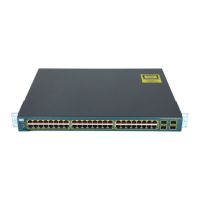30-5
Catalyst 3560 Switch Software Configuration Guide
78-16156-01
Chapter 30 Configuring IP Unicast Routing
Configuring IP Addressing
Assigning IP Addresses to Network Interfaces
An IP address identifies a location to which IP packets can be sent. Some IP addresses are reserved for
special uses and cannot be used for host, subnet, or network addresses. RFC 1166, “Internet Numbers,”
contains the official description of IP addresses.
An interface can have one primary IP address. A mask identifies the bits that denote the network number
in an IP address. When you use the mask to subnet a network, the mask is referred to as a subnet mask.
To receive an assigned network number, contact your Internet service provider.
Beginning in privileged EXEC mode, follow these steps to assign an IP address and a network mask to
a Layer 3 interface:
IP forward-protocol If a helper address is defined or User Datagram Protocol (UDP) flooding is
configured, UDP forwarding is enabled on default ports.
Any-local-broadcast: Disabled.
Spanning Tree Protocol (STP): Disabled.
Turbo-flood: Disabled.
IP helper address Disabled.
IP host Disabled.
IRDP Disabled.
Defaults when enabled:
• Broadcast IRDP advertisements.
• Maximum interval between advertisements: 600 seconds.
• Minimum interval between advertisements: 0.75 times max interval
• Preference: 0.
IP proxy ARP Enabled.
IP routing Disabled.
IP subnet-zero Disabled.
Table 30-1 Default Addressing Configuration (continued)
Feature Default Setting
Command Purpose
Step 1
configure terminal Enter global configuration mode.
Step 2
interface interface-id Enter interface configuration mode, and specify the Layer 3
interface to configure.
Step 3
no switchport Remove the interface from Layer 2 configuration mode (if it is a
physical interface).
Step 4
ip address ip-address subnet-mask Configure the IP address and IP subnet mask.
Step 5
no shutdown Enable the interface.
Step 6
end Return to privileged EXEC mode.

